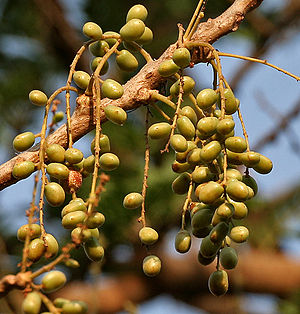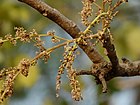Note: This is a project under development. The articles on this wiki are just being initiated and broadly incomplete. You can Help creating new pages.
Lannea coromandelica - Jhingini
Revision as of 14:11, 30 April 2019 by Arun93 (talk | contribs) (Created page with "thumb|right|''Jhingini'', ''Lannea coromandelica'' '''Jhingini''' is a deciduous tree usually gro...")
Jhingini is a deciduous tree usually growing 5 - 10 metres tall but with some specimens up to 20 metres tall with a bole 45cm in diameter. The leaves are gathered from the wild for local use as food and medicine. The plant is also cultivated in some areas of the tropics as a hedge plant and roadside tree
Contents
- 1 Uses
- 2 Parts Used
- 3 Chemical Composition
- 4 Common names
- 5 Properties
- 6 Habit
- 7 Identification
- 8 List of Ayurvedic medicine in which the herb is used
- 9 Where to get the saplings
- 10 Mode of Propagation
- 11 How to plant/cultivate
- 12 Commonly seen growing in areas
- 13 Photo Gallery
- 14 References
- 15 External Links
Uses
Sprains, Inflammation, Cuts and burns, Dysentery [1]
Parts Used
Chemical Composition
Common names
| Language | Common name |
|---|---|
| Kannada | ajashringi, goddi mara, dhumpaarikuratike |
| Hindi | jhingan, kashmal |
| Malayalam | kalasu, kalesjam, karasu, karayam, otiyamaram, thingam, udi |
| Tamil | anaikarai, vodiyar, odiya-maram, odiyan |
| Telugu | goompana chettu, gumpena, oddimanu, dhumpari |
| Marathi | NA |
| Gujarathi | NA |
| Punjabi | NA |
| Kashmiri | NA |
| Sanskrit | ajasringgi, jhingini, gudamanjari, netrashuddhi, jhingi, jivala, kvala, manjari |
| English | Indian ash tree |
Properties
Reference: Dravya - Substance, Rasa - Taste, Guna - Qualities, Veerya - Potency, Vipaka - Post-digesion effect, Karma - Pharmacological activity, Prabhava - Therepeutics.
Dravya
Rasa
Guna
Veerya
Vipaka
Karma
Prabhava
Habit
Identification
Leaf
| Kind | Shape | Feature |
|---|---|---|
| Pinnate | alternate | Leaves bipinnate, alternate, stipulate, rachis 14.5-62.5 cm long, stout, with a gland at the tip. Pinnae 2-3 pairs, leaflets 8-20, alternate Leaves imparipinnate, alternate, clustered at the end of branchlets, estipulate; rachis 21-27 cm, stout, swollen at base, stellate-hairy pubescent when young; leaflets 7-11, opposite; petiolule 3-5 mm, slender, pubescent; lamina 5-12 x 3-8 cm, oblong, oblong-ovate, oblong-lanceolate or ovate, base oblique, acute or round, apex acuminate, margin entire, lower surface and part of the upper with scattered stellate pubescence, chartaceous; lateral nerves 10-16 pairs, parallel, prominent, puberulent beneath, intercostae reticulate, prominent. |
Flower
| Type | Size | Color and composition | Stamen | More information |
|---|---|---|---|---|
| Axillary | axillary or terminal racemes | Yellowish green | 8 | male flowers : in compound racemes, 8 mm across; calyx 4-lobed; lobes ovate, imbricate, persistent; petals 4, lanceolate, reflexed, imbricate; disc annular, 8-lobed; stamens 8, inserted below the disc, filaments unequal, subulate, ovary abortive; female flowers : in simple racemes; petals and sepals as in male flowers; stamens very short and small; anthers sterile; ovary superior, ovule pendulous from near the top of the cell.; styles 4; stigma peltate. |
Fruit
| Type | Size | Mass | Appearance | Seeds | More information |
|---|---|---|---|---|---|
| A drupe | 12 mm long | ovoid, red; stone hard; seed compressed. | {{{6}}} |
Other features
List of Ayurvedic medicine in which the herb is used
Where to get the saplings
Mode of Propagation
How to plant/cultivate
Season to grow
Soil type
Propagation
Commonly seen growing in areas
Tropical area, Sub tropical area
Photo Gallery
References
External Links
- [tropical.theferns.info/viewtropical.php?id=Lannea+coromandelica]
- [1]
Categories:
- Ayurvedic Herbs known to be helpful to treat Sprains
- Ayurvedic Herbs known to be helpful to treat Inflammation
- Ayurvedic Herbs known to be helpful to treat Cuts and burns
- Ayurvedic Herbs known to be helpful to treat Dysentery
- Herbs with Bark used in medicine
- Herbs with Leaves used in medicine
- Herbs with common name in Kannada
- Herbs with common name in Hindi
- Herbs with common name in Malayalam
- Herbs with common name in Tamil
- Herbs with common name in Telugu
- Herbs with common name in Sanskrit
- Herbs with common name in English
- Habit - Tree
- Index of Plants which can be propagated by Seeds
- Index of Plants which can be propagated by Cuttings
- Herbs that are commonly seen in the region of Tropical area
- Herbs that are commonly seen in the region of Sub tropical area
- Herbs
- Plants of western ghats
- Tree




